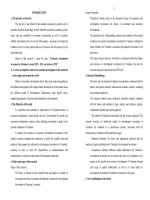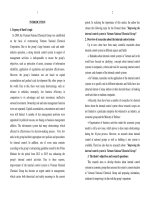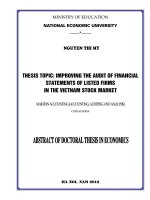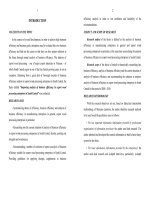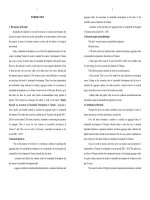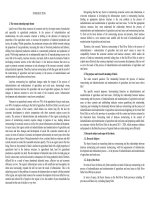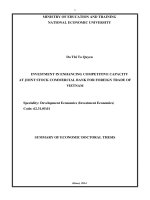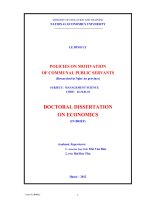Nghiên cứu nồng độ copeptin huyết thanh trong tiên lượng bệnh nhân tai biến mạch máu não giai đoạn cấp TOM TAT TIENG ANH
Bạn đang xem bản rút gọn của tài liệu. Xem và tải ngay bản đầy đủ của tài liệu tại đây (753.64 KB, 27 trang )
HUE UNIVERSITY
UNIVERSITY OF MEDICINE AND PHARMACY
NGUYEN THANH CONG
RESEARCH IN SERUM COPEPTIN
CONCENTRATION IN PREDICTING CLINICAL
OUTCOMES FOR ACUTE STROKE PATIENTS
THESIS OF DOCTOR OF MEDICINE
HUE - 2019
The thesis is completed at
HUE UNIVERSITY - UNIVERSITY OF MEDICINE AND
PHARMACY
Scientific supervisor:
1. ASSOC. PROF. DR. LE THI BICH THUAN
2. ASSOC. PROF. DR. LE CHUYEN
Reviewer 1:
Reviewer 2:
Reviewer 3:
The thesis was defended at the council granting the thesis at the Hue
University level
At………….., day………..month……..year…….
The doctoral thesis can be achieved at the following libraries:
-
National library of Vietnam
-
Learning Resource Center – Hue University
-
Library of Hue University of Medicine and Pharmacy
INTRODUCTION
1. Problem statements
Stroke is the first most common disease cause of disability and
third most common cause of death worldwide. Searching for
prognostic factors and risk stratification are very important. A good
prognostic outcome to help doctors make decisions regarding
treatment strategies for acute stroke patients.
Arginine vasopressin (AVP), a biomarker, produced by
hypothalamic neurons, is stored and released from the posterior
pituitary gland following different stimuli such as hypotension,
hypoxia, hyperosmolarity, acute stroke,... Measurement of AVP
level has limitations due to its short biological half-life and
instability. Copeptin is the C-terminal portion of provasopressin, and
released with vasopressin during the metabolism of the precursor.
Copeptin is a more stable peptide and easily measured in serum and
plasma, is a representative agent for assessing vasopressin levels.
Copeptin, which is the evidence for the equivalent existence, directly
involved in stroke pathology is vasopressin. In stroke patients, copeptin
levels increased significantly in serum early and increased levels
correlated with the serious disease status so it had high value in
prognosis. Indeed, many studies have shown that copeptin was
significantly associated with mortality and with a poor functional
outcome in ischemic stroke and intracerebral hemorrhage patients.
In Vietnam, there has been no study carrying out research into
the copeptin concentration in stroke. Therefore, we study the subject
“Research in serum copeptin concentration in predicting clinical
outcomes for acute stroke patients”
2. Objectives
2.1. Determine serum copeptin concentration in acute stroke
patients (ischemic stroke and intracerebral hemorrhage).
2.2. Evaluate the prognostic value of copeptin to predict in clinical
outcome of acute stroke patients and correlation between copeptin with
size of cerebral injury, using NIHSS scale, Glasgow scale, hs-CRP,
Fibrinogen, blood glucose, HbA1c, white blood cell counts.
1
3. Scientific and practical meaning
3.1. Scientific meaning
3.1.1. Copeptin reflects AVP concentration and can be used as a
replacement biomarker of AVP release. It is directly involved in stroke
pathology. Copeptin is released in acute stroke patients. Copeptin,
which is a biomarker, plays a supporting role in diagnosis of
neuroimaging results in acute stroke patients, this helps observe and
make accurate prognosis in acute stroke patients. Thus, measurement
of copeptin has importantly scientific meaning to contribute prognosis
in acute stroke patients.
3.1.2. The diagnosis of acute stroke patients at where the
facilities and capacity has till had some restrictions of neuroimaging
technique, it is mostly difficult to diagnose acute stroke with unclear
images. Therefore, determination of copeptin in serum can be tested
many times, this has extremely useful contribution towards diagnosis,
prognosis.
3.2. Practical meaning
3.2.1. This thesis contributes practical meaning because copeptin
can be measured in acute phase of stroke and performed several
times. Thence, it considerably helps in diagnosis, prognosis in stroke
patients.
3.2.2. Increased levels of copeptin contribute prognosis of
disease progress in acute stroke patients.
3.2.3. Copeptin levels have correlation with other factors as size
of cerebral injury, blood glucose, hs-CRP,… severity of stroke by
Glasgow scale, NIHSS scale.
4. Contribution of the thesis
This thesis has been the first study conducted in Vietnam about
copeptin in acute stroke patients.
Measurement of copeptin in acute stroke patients plays valuable
contribution to help diagnosis, observation, prognosis, and helps
doctors have better scheduled therapy.
- Structure of the thesis: the thesis consists of 136 pages
including 4 pages of introduction, 32 pages of literature review, 26
pages subjects and methods, 36 pages of research results, 35 pages of
discussion, 2 pages of conclusion and 1 pages recommendations. There
are 45 tables, 26 diagrams, 7 figures, 140 references with 31
Vietnamese and 109 English references in the thesis.
2
Chapter 1
LITERATURE REVIEW
1.1. PATHOPHYSIOLOGY OF STROKE
1.1.1. Ischemic stroke
The two main pathology of ischemic strokes are arterial
occlusion or stenosis (Thrombosis, embolism) and systemic
hypoperfusion.
1.1.2. Intracerebral hemorrhage
There are two main pathology of spontaneous intracerebral
hemorrhage, which are Charcot and Bouchard’ theory attributed
bleeding to rupture at points of dilatation in the walls of small
arterioles and Rouchoux’ theory.
1.2. THE PROGNOSTIC FACTORS OF ACTE STROKE
1.2.1. The prognostic factors of ischemic stroke
The prognostic factors of ischemic stroke consist of neurologic
severity, age, neuroimaging, infarct volume, infarct location, other
imaging findings, ischemic stroke mechanism, the association with
pre-stroke comorbidities and complications of stroke.
1.2.2. The prognostic factors of intracerebral hemorrhage
Factors which have been consistently identified as prediction of
a high mortality rate comprise as follows: Age > 65 years old, body
temperature > 380C, a low score on the Glasgow Coma Scale, a large
volume of the hematoma, and the presence of ventricular blood on
the initial CT scan.
1.2.3. Biomarkers in predicting for stroke
Biomarkers were previously applied in stroke studies including:
MMP-9 (Matrix metalloproteinase-9), Cellular-fibronectin, S100β
proteins, NSE, Human C-reactive protein, PAI-1, TNFα ,… In
addition, a recent study has showed the important role of copeptin in
predicting outcome and mortality of acute stroke.
1.3. COPEPTIN- A BIOMARKER IN STROKE
1.3.1. Introduction
Copeptin is a glycosylated 39 amino acid long peptide with
leucine rich core segment. Its molecular weight is 4021 daltons.
Copeptin, a C-terminal part of pre-provasopressin, the precursor of
Arginine Vasopressin (AVP), is released together in stoichiometric pattern
3
from the hypothalamus upon stimulation of AVP release. Copeptin is
more stable than AVP itself and it is released in a 1:1 ratio to AVP.
1.3.2. Physiological functions of AVP/copeptin
AVP produces its cellular effects through interaction with
its three G-protein coupled receptors. The V1a receptor is
predominantly found in vascular smooth muscle, it involves in the
control of vasoconstrictor effects and blood pressure regulation. V1b
receptors (also named AV3R) are primarily located on specialized
cells, called corticotrophs, in the anterior pituitary gland, where they
stimulate the release of adrenocorticotropic hormone (ACTH)
synergistically with corticotropin releasing hormone (CRH). V1a and
V1b receptors are found in the brain. The V2 receptor expressed on
kidney cells is responsible for water reabsorption, hence it is assumed
that AVP an important hormone in hemostasis.
Copeptin/AVP as neuroendocrine peptides of stress
In 2008, Katan, M. and his colleagues reported significant positive
correlation between plasma copeptin and individual stress level.
Copeptin is surrogate marker for AVP
AVP is derived together with three other peptides from a larger
precursor peptide. One of these peptides, namely copeptin, is more
stable than AVP and is released in a 1:1 ratio to AVP. The close
relationship between copeptin and mature AVP is further confirmed
by the good correlation between these two peptides. Being taken
together, these observations confirm that copeptin behaves like AVP
and could serve as a surrogate marker for AVP release.
1.3.3. Pathophysiology of copeptin in stroke
An acute ischemic thromboembolic stroke is coupled with
acute brain injury, increased oxidative stress, and a complex
cascade of metabolic events leading to neuronal cell death. Acute
brain ischemia also activates a complex sequence of events in the
central nervous system and the hypothalamic– pituitary–adrenal
axis, this leads to increase in vasopressin/copeptin levels.
Vasopressin and vascular regulation
Vasopressin receptors are widely distributed throughout the
brain. They are present in neurons, astrocytes and their perivascular
processes, blood vessel endothelial and smooth muscle cells, and the
choroid plexus. These locations suggest that vasopressin may
4
participate in regulating vascular resistance in the cerebral circulation
and water homeostasis in the brain.
Vasopressin and water homeostasis
Several studies have demonstrated that vasopressin participates
in the physiological regulation of ion/water homeostasis in the brain.
Based on the data on the stimulatory effect of vasopressin on water
transfer through the blood brain barrier, many experimental studies were
performed to find out whether inhibition of vasopressin synthesis
ameliorates brain edema following stroke, subarachnoid hemorrhage or
brain trauma. Possible participation of vasopressin in brain pathology
following ischemia was supported by the observations of the increased
expression of mRNA for vasopressin and increased plasma concentration
of AVP following experimental ischemia. The increased AVP plasma
levels also have been reported in stroke patients. It has been shown that
administration of AVP exacerbates acute ischemic brain edema and this
exacerbation can be reduced by the inhibition of released AVP. Moreover,
attenuation of brain swelling was observed following administration of
V1a. Vasopressin is one of the factors participating in vasogenic edema
and cellular swelling after stroke.
Thus, levels of vasopressin/copeptin are increased in acute
stroke due to stress reaction through the hypothalamic– pituitary–
adrenal axis. The increased AVP/copeptin plasma levels by V1a receptor
in stroke patients causes blood brain barrier injury, vasogenic edema and
cellular swelling.
1.4. RESEARCH ON COPEPTIN IN STROKE PATIENTS
A study by Alemam, A. I. et al. (2016) on ischemic stroke
patients, the results showed high statistically significant correlation
between the mean values of copeptin concentration and severity of
stroke on admission (p < 0,001), and the size of the infarction (p <
0,001). The favorable outcome of the stroke was with cutoff point of
copeptin below 21,5 ng/mL. Therefore, it is concluded that serum
copeptin may help in the prediction of severity of ischemic stroke
and functional outcome. Another study by Dong, X. Q. et al. on 86
ICH patients showed that there was a good correlation between levels
of plasma copeptin and NIHSS score (r = 0,733, p < 0,01). The
plasma copeptin level was an independent predictor for 1-week
mortality [OR = 1,013 (95% CI: 1,003–1,023); p = 0,009]. According
to the study of Zhang, X. et al. (2012), the mean of plasma copeptin
5
levels in patients was statistically higher than that in healthy
controls (24,3 ± 12,4 pmol/L versus 5,4 ± 1,6 pmol/L; p <
0,001). The plasma copeptin levels are considered as an independent
predictor for 1-year mortality, 1-year unfavorable outcome
(modified Rankin Scale score > 2) and early neurological
deterioration (Early neurological deterioration was defined as the
increase of ≥4 points in the NIHSS score at 24h from
symptoms onset). Furthermore, Dong, X. Q. et al. (2011) showed
that significant correlation between baseline plasma copeptin level
and hematoma volume (r = 0,552; p < 0,0001). Higher baseline
plasma copeptin level was associated with 1-week mortality.
Baseline plasma copeptin level as the independent predictors for 1week mortality (OR = 1,013, 95% CI, 1,003-1,023; p<0,001).
In Vietnam, so far there has been no study conducting research
in copeptin concentration in stroke patients.
6
Chapter 2
SUBJECTS AND METHODS
2.1. SUBJECTS
Research subjects were 18 years of age and older include:
patients’ group and control group.
2.2.1. Patients’ group
Include 92 acute stroke patients (48 ischemic stroke patients and
44 intracerebral hemorrhage patients) hospitalized at the Department
of Internal Medicine Cardiology, Intensive Care Unit of Hue
University Hospital from September 2015 to December 2017 and
voluntarily participated in the research were recruited . Exclusion
criteria were stroke through the acute stage, subarachnoid
hemorrhage, head trauma, other central nervous system
diseases (Parkinson's disease, Huntington's disease, seizure disorder),
autoimmune diseases with or without immunosuppressive therapy,
renal insufficiency, liver cirrhosis, lung disease, pregnant women,
using antiplatelet or anticoagulant medication, using corticosteroids,
syndrome of inappropriate antidiuretic hormone secretion, heart
failure, co-existent ischemic heart disease, diabetes insipidus.
2.1.2. Control group
Include a control group - 64 people who were the same age, sex
as patients' group, examined health at Hue University Hospital. They
did not have the diseases included in the exclusion criteria mentioned
above and agreed to participate in the research.
2.2. METHODS
Cross-sectional descriptive, comparative with the control group.
A sample size of > 88 participants (n > 47 ischemic stroke
patients and n > 41 intracerebral hemorrhage patients) was recruited
based on the formula of sample size calculation estimating an
average. We selected 92 patients with the disease group (n = 48
ischemic stroke patients and n = 44 intracerebral hemorrhage
patients) and the control group were 64 cases.
2.2.3. Clinical variables
Clinical status and severity of disease were assessed on
admission and on the seventh day after admission. On admission: the
Glasgow Coma Scale (GCS) score and the National Institutes of
Health Stroke Scale (NIHSS) score were assessed on patients. The
7
blood glucose, HbA1c, hs-CRP, fibrinogen, white blood cell counts,
serum copeptin levels were measured. On the seventh day after
admission: the GCS score and the NIHSS score were assessed.
Serum copeptin levels were measured.
Assess the severity of stroke through scale stroke of National
Institutes of Health Stroke Scale - NIHSS, it was divided into two groups:
mild to moderate (<15 scores), severe and very severe (≥ 15 scores).
2.2.4. Size of cerebral injury was assessed with the computed
brain tomography
Performed on SOMATOM Scope (Siemens, Germany) and the
results were concluded by doctors at the Department of Medical
Imaging of Hue University Hospital.
2.2.5. Measurement of white blood cell counts, hs-CRP,
fibrinogen Performed at the Department of Hematology of Hue
University Hospital.
2.2.6. Measurement of blood glucose, HbA1c Performed at the
Department of Biochemistry of Hue University Hopital.
2.2.7. Determination of copeptin in serum
The concentration of copeptin in serum was analyzed by
Enzyme Immunoassay using Enzyme Immunoassay Kit purchased
from Phoenix Pharmaceuticals (Burlingame, CA, USA). Performed
at the Department of Immunology and Pathophysiology of Hue
University Hospital.
2.3. DATA COLLECTION METHOD
The questionaire was designed and collected information was
recorded. Data were analyzed by using SPSS (Statistical Package for
Social Science) 20.0 software.
2.4. ETHICAL CONSIDERATION
The study was approved by Scientific Council and Ethics
Council of Hue University of Medicine and Pharmacy, Hue
University Hopital. Patients and/ or patients' families were fully
informed and agreed to take part in the research, committed to
cooperate throughout the research. Patients may withdraw from the
research for any reason. The personal information of the research
subjects is completely confidential, only the researcher can access.
8
Chapter 3
RESULTS
3.1. CHARACTERISTICS OF STUDY SUBJECTS
3.1.1. Characteristics of ischemic stroke patients
Table 3.1. Characteristics of ischemic stroke patients
and control group
Ischemic
Control
stroke
group
Factors
p
(n = 48)
(n = 64)
Male (n,%)
25 (52,1%) 34 (53,1%) >0,05
Female (n,%)
23 (47,9%) 30 (46,9%) >0,05
68,96±10,03 66,02±5,68 >0,05
Mean age (year) ( X ±SD)
68,68±9,37
Mean age of male (year) ( X ±SD)
66,32±5,17 >0,05
Mean age of female (year) ( X ±SD) 69,26±10,91 65,67±6,27 >0,05
There are similarities in age, sex between the Ischemic stroke
group and the control group.
3.1.2. Characteristics of intracerebral hemorrhage patients
Table 3.2. Characteristics of intracerebral hemorrhage patients
and control group
Intracerebral
Control
hemorrhage
group
Factors
p
(n = 44)
(n = 64)
Male (n,%)
24 (54,5%)
34 (53,1%) >0,05
Female (n,%)
20 (45,5%)
30 (46,9%) >0,05
65,61±13,82
66,02±5,68 >0,05
Mean age (year) ( X ±SD)
68±11,43
Mean age of male (year) ( X ±SD)
66,32±5,17
>0,05
62,75±16,08
65,67±6,27 >0,05
Mean age of female (year) ( X ±SD)
There are similarities in age, sex between the intracerebral
hemorrhage group and the control group.
9
3.2. SERUM COPEPTIN CONCENTRATION OF STUDY
SUBJECTS
Table 3.3. Serum copeptin concentration in stroke patients
and control group
Copeptin
Ischemic
Intracerebral
Control
admisson
stroke (1)
hemorrhage (2)
group (3)
(pmol/L)
(n = 48)
(n = 44)
(n = 64)
Mean±SD
11,21±5,32
9,69±6,46
4,5±2,2
Median
11,1
8
3,17
(IQR)
(7,32–14,73)
(3,87–13,92)
(2,6–6,54)
p
(1) & (3) < 0,001; (2) & (3) < 0,001;
(1) & (2) > 0,05
Serum copeptin concentration in stroke patients on admission
was significantly higher than that in control group. However, serum
copeptin concentration in stroke patients was not significantly
different between the IS and ICH. (IS: ischemic stroke, ICH:
intracerebral hemorrhage, IQR: Interquartile range)
Table 3.4. The serum copeptin concentration on admission and
on the seventh day after admission
Stroke
Ischemic
Intracerebral
patients
stroke
hemorrhage
Copeptin
(n = 48)
(n = 44)
(pmol/L)
Mean±SD
Admission
11,21±5,32
9,69±6,46
The seventh
9,26±5,19
6,62±5,12
day after
admission
Median
11,1
8
Admission
(IQR)
(7,32–14,73)
(3,87–13,92)
The seventh
9,85
3,68
day after
(4,68-12,38)
(2,98–8,38)
admission
p
< 0,001
< 0,001
The serum copeptin concentration of the CI and ICH on
admission was significantly higher than that on the seventh day
after admission.
10
Bảng 3.5. The serum copeptin concentration on male and female
in the ischemic stroke patients and control group
Copeptin
Ischemic stroke
Control group
admission
Male (1) Female (2) Male (3) Female (4)
(pmol/L)
(n= 25)
(n = 23)
(n= 34)
(n = 30)
Mean±SD 10,71±5,14 11,74±5,58 4,40±2,18 4,59±2,27
Median
10,5
13,2
3,07
3,33
(IQR)
(6,76–14,65) (7,36–16,71) (2,57–6,6) (2,63–6,65)
p
(1) & (3) < 0,001; (2) & (4) < 0,001;
(1) & (2) > 0,05; (3) & (4) > 0,05
The serum copeptin concentration of male and female in the
ischemic stroke patients was higher than that of control group with
statistical significance. There was no significant difference of
serum copeptin concentration between male and female in the
ischemic stroke and control group.
Table 3.6. The serum copeptin concentration on male and female
in the intracerebral hemorrhage patients and control group
Copeptin Intracerebral hemorrhage
Control group
admission
Male (1)
Female (2)
Male (3)
Female (4)
(pmol/L)
(n = 24)
(n = 20)
(n= 34)
(n = 30)
Mean±SD 10,39±6,84
8,85±6,04
4,40±2,18
4,59±2,27
Median
(IQR)
8,39
(4,4–17,74)
7,14
(3,6–13,88)
p
3,07
(2,57–6,6)
3,33
(2,63–6,65)
(1) & (3) < 0,001; (2) & (4) < 0,01;
(1) & (2) > 0,05; (3) & (4) > 0,05
The serum copeptin concentration of male and female in the
intracerebral hemorrhage was higher than that of control group
with statistical significance. There was no significant difference of
serum copeptin concentration between male and female in the
intracerebral hemorrhage and control group.
3.3. ROLE OF COPEPTIN IN PROGNOSIS CLINICAL
OUTCOMES FOR ACUTE STROKE PATIENTS AND
CORRELATION BETWEEN COPEPTIN WITH SIZE OF
CEREBRAL INJURY, NIHSS SCALE, GLASGOW SCALE, hsCRP, FIBRINOGEN, BLOOD GLUCOSE, HbA1c, WHITE
BLOOD CELL COUNTS
11
3.3.1. The serum copeptin concentration in clinical severity of
stroke (using NIHSS)
Table 3.7. The serum copeptin concentration on admission in
clinical severity of stroke on the seventh day after admission
Ischemic stroke
Intracerebral hemorrhage
on the seventh day after
on the seventh day after
admission
admission
Copeptin
NIHSS
NIHSS
NIHSS
NIHSS
admission
< 15 score
≥ 15 score
< 15 score
≥ 15 score
(pmol/L)
(n= 37)
(n = 11)
(n= 36)
(n = 8)
Mean±SD
9,51±4,46
16,92±3,86
7,61±4,46
19,02±5,94
Median
9,7
15,34
6,10
20,27
(IQR)
(5,95–13,00) (13,80–21,50) (3,69–11,35) (15,30–23,17)
p
< 0,001
< 0,001
The serum copeptin levels on admission in clinical severity of
stroke on the seventh day after admission were significantly higher
than that in mild of stroke on seven days after admission.
3.3.2. The serum copeptin levels predicting severity outcomes for
acute stroke patients
Table 3.8. Cut-off value of copeptin admission predicting severity
(using NHSS) outcomes for acute ischemic stroke
CutSe
Sp
Factor
AUC
95% CI
p
off
(%)
(%)
Copeptin admission
0,78
0,62-0,95 13,25
81,8
75,7 <0,01
(pmol/L)
Copeptin on the seventh
day after admission
0,78
0,63-0,92
8
90,9
51,4 <0,01
(pmol/L)
Copeptin levels predicting severity outcomes for acute IS. Cutoff value of copeptin admission ≥ 13,25 pmol/L (Se = 81,8%, Sp
75,7%) and cut-off value of copeptin on the seventh day after
admission ≥ 8 pmol/L (Se = 90,9%, Sp = 51,4%)
Table 3.9. The cut-off value of copeptin concentration on admission
in predicting severity of acute intracerebral hemorrhage patients
(using NIHSS)
CutSe
Sp
Factor
AUC
95% CI
p
off
(%) (%)
Copeptin on admission 0,83
0,70-0,97 13,91 66,7 90,6 <0,001
(pmol/L)
Copeptin on the
seventh day after
0,75
0,52-0,98 8,72 62,5 86,1 <0,05
admission (pmol/L)
12
Copeptin levels predict severity outcomes for acute ICH. Cut-off
value of copeptin at admission ≥ 13,91 pmol/L (Se = 66,7%, Sp =
90,6%) and cut-off value of copeptin on the seventh day after
admission ≥ 8,72 pmol/L (Se = 62,5%, Sp = 86,1%)
3.3.3. Prognostic value of copeptin in clinical severity of acute
stroke patients
3.3.3.1. Prognostic value of copeptin on admission in clinical
severity (using NIHSS) of stroke patients on admission
Table 3.10. Multivariate regression analysis of related factors to
predict clinical severity of ischemic stroke patients
(using NIHSS) on admission
Factor
β
SE
P
Copeptin admission (pmol/L) 0,442
0,112
< 0,001
Infartc volume (cm3)
0,031
0,03
> 0,05
Constant
5,176
A multivariate analysis identified serum copeptin level on
admission as an independent predictor for severity of IS (using NIHSS).
Table 3.11. Multivariate regression analysis of related factors to
predict clinical severity of intracerebral hemorrhage patients
(using NIHSS) on admission
Factor
β
SE
p
Copeptin admission (pmol/L)
0,515
0,181
< 0,01
Hematoma volume (cm3)
0,094
0,068
> 0,05
Constant
4,064
A multivariate analysis identified serum copeptin level on
admission as an independent predictor for severity of ICH (using
NIHSS) on admission.
3.3.3.2. Prognostic value of copeptin on admission in clinical severity
of stroke patients (using NIHSS) on the seventh day after admission
Table 3.12. Multivariate logistic regression models analysis of factors to
predict clinical severity of ischemic stroke patients (using NIHSS)
on the seventh day after admission
Factor
OR
95% (CI)
p
Copeptin admission (pmol/L)
1,493
1,093 – 2,040 < 0,05
Infartc volume (cm3)
1,058
0,996 – 1,125 > 0,05
White blood cell counts (x 109/L)
1,253
0,654 – 2,399 > 0,05
Evaluate, statistics model: Corrected priority value expected 89,6%:
Hosmer and Lemeshow: χ2 = 1,401, df = 8, p > 0,05
13
Multivariate analysis showed serum copeptin level on admission
was an independent predictor for clinical severity of ischemic stroke
patients on the seventh day after admission OR = 1,493 (95% CI:
1,093 – 2,040), p < 0,05.
Table 3.13. Multivariate logistic regression models analysis of factors to
predict clinical severity of intracerebral hemorrhage patients (using
NIHSS) on the seventh day after admission
Factor
OR
95% (CI)
p
Copeptin admission (pmol/L)
1,419
1,048 – 1,921
< 0,05
3
Hematoma volume (cm )
1,013
0,94 – 1,091
> 0,05
Evaluate, statistics model: Corrected priority value expected 89,6%:
Hosmer and Lemeshow: χ2 = 1,401, df = 8, p > 0,05
Multivariate analysis showed serum copeptin level on admission
was an independent predictor for clinical severity of ICH on the
seventh day after admission OR = 1,419 (95% CI: 1,048 – 1,921, p
< 0,05).
3.3.4. Correlation between copeptin with size of cerebral injury,
NIHSS scale, Glasgow scale, hs-CRP, Fibrinogen, blood glucose,
HbA1c, white blood cell counts
3.3.4.1. Correlation between serum copeptin levels on admission
with other prognostic factors in ischemic stroke patients
Table 3.14. Baseline clinical and laboratory factors correlated with
serum copeptin levels on admission in ischemic stroke patients
Copeptin admission
(pmol/L)
Linear correlation
r
p
equations
Factors
Infartc volume (cm3)
0,301 <0,05
y = 1,132x+1,316
Glasgow scale on admission
-0,649 <0,001 y = –0,185x+15,572
NIHSS scale on admission
0,550 <0,001
y = 0,477x+5,217
Blood glucose (mmol/L)
0,467 <0,01
y = 0,191x+4,432
hs-CRP (mg/L)
0,467 <0,01
y = 1,839x-8,151
Fibrinogen (g/L)
0,287 <0,05
y = 0,067x+2,858
White blood cell counts (x 109/L)
0,463 <0,01
y = 0,233x+5,887
14
In IS patients on admission, serum copeptin correlated
positively with infartc volume, NIHSS scale, blood glucose,
fibrinogen, white blood cell counts whereas copeptin correlated
negatively with Glasgow scale
3.3.4.2. Correlation between serum copeptin levels on admission
with other prognostic factor in intracerebral hemorrhage patients
Table 3.15. Baseline clinical and laboratory factors correlated with
serum copeptin levels on admission
in intracerebral hemorrhage patients
Copeptin admission
Linear correlation
(pmol/L)
r
p
equations
Factors
3
Hematoma volume (cm )
0,749 <0,001
y = 2x–4,635
Glasgow scale on admission
-0,712 <0,001 y = –0,217x+15,53
NIHSS scale on admission
0,666 <0,001
y = 0,702x+3,63
Blood glucose (mmol/L)
0,367
y = 0,061x+5,485
<0,05
HbA1c (%)
0,375 < 0,05
y = 0,031x+5,429
In ICH patients on admission, serum copeptin correlated
positively with with hematoma volume, NIHSS scale, blood glucose,
HbA1c whereas copeptin correlated negatively with Glasgow scale
3.3.4.3. Correlation between serum copeptin levels on the seventh
day after admission with NIHSS scale, Glasgow scale
Table 3.16. Correlation between serum copeptin levels on the
seventh day after admission with NIHSS scale, Glasgow scale
Copeptin on
the seventh day after
admission (pmol/L)
Linear
NIHSS scale,
r
p
correlation
Glasgow scale
equations
on the seventh
day after admission
NIHSS scale in IS patients
0,416
y = 0,611x+5,41
<0,01
NIHSS scale in ICH patients
0,700 <0,001 y = 0,881x+4,009
Glasgow scale in IS patients
-0,501 <0,001 y = -0,192x+15,379
Glasgow scale in ICH patients
-0,689 <0,001 y = -0,266x+15,651
In stroke patients on the seventh day after admission, serum
copeptin correlated positively with NIHSS scale, whereas copeptin
correlated negatively with Glasgow scale.
15
Chapter 4
DISCUSSION
4.1. CHARACTERISTICS OF STUDY SUBJECTS
In this study, the mean age in ischemic stroke (IS) was 68,96 ±
10,03 years (male 52,1%, female 47,9%). The mean age in
intracerebral hemorrhage (ICH) was 65,61 ± 13,82 years (male
54,5%, female 45,5%). There was similarities in age, sex between the
patients, group and the control group (p>0,05) (Table 3.1, table 3.2).
As the study of Wei, Z. J. et a.l (2014), 271 patients were diagnosed
as acute ICH, with the median age of patients being 69 (IQR 59–81),
in which females accounted for 46,9 %.
4.2. SERUM COPEPTIN CONCENTRATION OF STUDY
SUBJECTS
Admission median serum copeptin concentration in IS patients
[11,1 pmol/L (IQR; 7,32 – 14,73)], ICH [8 pmol/L (IQR; 3,87 –
13,92)] were statistically higher than that in healthy controls
[3,17 pmol/L (IQR; 2,6 – 6,54)]. But the serum level of copeptin is
not different between CI and ICH group (Table 3.3).
Based on a study by Zhang, J. L. et al. (2013), the results showed
that there was a significant difference in median plasma copeptin levels
between acute ischemic stroke patients and control cases [12,4 pmol/L
(IQR: 6,4 – 22,8) vs 3,9 pmol/L (IQR: 3,6 – 9,5), respectively, p <
0,0001]. According to the study of Zhang, X. et al. (2012), the mean
plasma copeptin level in ICH patients was statistically higher than
that in healthy controls (24,3 ± 12,4 pmol/L [range, 8,8–54,8
pmol/L] versus 5,4 ± 1,6 pmol/L [range, 3,3–8,3 pmol/L]; p <
0,001). Aksu, F. et al. (2016), copeptin levels in patients with IS [5,49
ng/dL (IQR: 4,73-6,96)], ICH [4,5 ng/dL (IQR: 3,04-9,77)] are
significantly higher than healthy volunteers [2 ng/dL (IQR: 1,57-2,5)].
However, in spite of the high levels of copeptin, no statistically
significant difference was found between IS and ICH. Sarfo, F. S. et al.
(2018), copeptin levels in patients with IS [26,3 ± 7,4 pmol/L], ICH
[20,7 ± 6,8 pmol/L] are significantly higher than control cases [6,6 ±
10,7 pmol/L]. Copeptin was marginally higher among IS subjects
compared with ICH, with mean ± SD measurement of 26,3 ± 7,4 pmol/L
versus 20,7 ± 6,8 pmol/L, p = 0,08.
In our study, the serum copeptin concentration on admission
was significantly higher than that on the seventh day after admission
in stroke patients (table 3.4).
16
Dong, X. Q. et al. (2011) showed that, after ICH, plasma copeptin
level in patients increased during the 6-h period immediately, and
peaked in 24 h, then decreased gradually, but always substantially higher
than that in healthy controls during the 7-day period. Zeng, X. et al.
(2016): Analysis of the time course of plasma copeptin levels showed
significant changes with the day of sampling, with the levels peaking on
day 1 (p<0,001; compared with days 2 to 5) and falling to a plateau by
days 3 to 5.
Based on the result of study, there was no significant difference
in copeptin levels between male and female in IS, ICH, control
group. The serum copeptin concentration of male and female in the
stroke patients was significantly higher than that of control group
(table 3.5 and table 3.6).
Wei, Z. J. et al. (2014) conducted the study of 271 ICH patients.
There was no difference in the levels of plasma copeptin in the sexes
(p = 0,563). Acocording to the study of Morgenthaler, N. G. et al.
(2007), median copeptin level in healthy controls was 4,1 pmol/L
(IQR: 1 – 13,8). There was no significant difference of copeptin
levels between men and women and no correlation with age.
4.3. ROLE OF COPEPTIN IN PREDICTING CLINICAL
OUTCOMES FOR ACUTE STROKE PATIENTS
4.3.1. Copeptin levels in plasma predicting severity outcomes for
acute stroke
Copeptin levels in plasma was able to predict severity
outcomes for acute IS, with cut-off value of copeptin admission ≥
13,25 pmol/L (Se = 81,8%, Sp 75,7%) and cut-off value of
copeptin on the seventh day after admission ≥ 8 pmol/L (Se =
90,9%, Sp = 51,4%) (table 3.8).
Zhang, J. L. et al. showed that the AUC of 0,75 (95% CI; 0,70 –
0,80), copeptine can used to differentiate the severity of acute IS,
with a significantly greater discriminatory ability as compared with
C-reactive protein, fibrinogen. A study by John, K. et al. (2017) on
60 acute IS patients, a cut-off copeptin value of 8,3 ng/ml showed a
sensitivity of 77,8%, specificity of 78,6% and AUC of 0,843 in
predicting poor outcomes.
Copeptin concentration in plasma was able to predict severity
outcomes for acute ICH, with cut-off value of copeptin admission ≥
13,91 pmol/L (Se = 66,7%, Sp = 90,6%) and cut-off value of
copeptin on the seventh day after admission ≥ 8,72 pmol/L (Se =
62,5%, Sp = 86,1%) (table 3.9).
17
Zhang, X. et al. studied 89 ICH patients and 50 healthy controls.
A cut-off copeptin value of > 26,3 pmol/L showed a sensitivity of
81,8% (95% CI; 59,7 – 94,7), specificity of 73,1% (95% CI; 60,9 –
83,2) and AUC of 0,848 (95% CI; 0,756–0,915) in predicting early
neurological deterioration (Early neurological deterioration was
defined as the increase of ≥4 points in the NIHSS score at 24 h
from symptoms onset). A study by Dong, X. Q. et al. (2011)
presented that plasma copeptin level >577,5 pg/mL predicted 1-week
mortality with 87,5% sensitivity and 72,2% specificity (AUC =
0,873; 95% CI, 0,784 – 0,935).
4.3.2. Prognostic value of copeptin for predicting clinical severity
of acute stroke patients
4.3.2.1. Prognostic value of copeptin on admission for predicting
clinical severity of ischemic stroke (using NIHSS) on admission
A multivariate analysis identified serum copeptin level on
admission as an independent predictor for severity of IS (by
NIHSS) on admission (table 3.10).
In this prospective, multicenter, cohort study, De Marchis, G. M.
et al. measured copeptin in the emergency room within 24 hours
from symptom onset in 783 patients with acute ischemic stroke. The
results showed that in multivariate analysis, higher copeptin (10-fold)
independently predicted unfavorable outcome, mortality, and
complications. A study by Alemam, A. I. et al. was conducted on 55
patients ischemic cerebral stroke admitted to Neurology Department,
Menofyia University within 24 hours of the onset of ischemic stroke.
The results showed high statistically significant correlation between
the mean value of copeptin level and severity of stroke (by NIHSS)
on admission.
4.3.2.2. Prognostic value of copeptin on admission for predicting
clinical severity of intracerebral hemorrhage (using NIHSS) on
admission
A multivariate analysis identified serum copeptin level on
admission as an independent predictor for severity of ICH (by
NIHSS) on admission (table 3.11).
In 40 consecutive patients who were admitted to the hospital
within 72 hours after a spontaneous ICH. According to Zweifel, C.
copeptin levels were higher in patients who died within 30 days
than in 30-day survivors. For the prediction of death, receiver
operating-characteristics analysis revealed an area under the curve
(AUC) for copeptin of 0,88 (95% CI: 0,75 - 1,00).
18
4.3.2.3. Prognostic value of copeptin on admission for predicting
clinical severity of ischemic stroke (using NIHSS) on the seventh
day after admission
In this study, the serum copeptin levels on admission in clinical
severity of ischemic stroke on the seventh day after admission were
significantly higher than that in mild of ischemic stroke on seven days
after admission (table 3.7). A multivariate analysis showed serum
copeptin level on admission was an independent predictor for clinical
severity of ischemic stroke patients on the seventh day after admission
[OR = 1,493 (95% CI: 1,093 – 2,040), p < 0,05] (table 3.12).
A meta-analysis by Xu, Q. et al. (2017) from 6 studies were total
of 1976 acute IS patients. Patients with poor outcomes and
nonsurvivors had a higher copeptin level at admission (p < 0,0001).
Elevation in plasma copeptin level carried a higher risk of all-cause
mortality (OR = 4,16; 95% CI: 2,77 – 6,25) and poor functional
outcome (OR = 2,56; 95% CI: 1,97 – 3,32) after acute ischemic
stroke. The meta-analysis by Jiao, L. et al. from the 11 studies (n
=1773) showed that copeptin is an independent prognostic marker of
poor outcome (OR = 2,52; 95% CI: 1,84 – 3,19). Five studies
(n=1704) evaluated the prognostic value of copeptin in patients with
acute ischemic stroke. The results showed that copeptin was an
independent predictor of mortality (OR = 2,70; 95% CI: 1,87 – 3,53).
4.3.2.4. Prognostic value of copeptin on admission for predicting
clinical severity of intracerebral hemorrhage (using NIHSS) on the
seventh day after admission
According to table 3.7, copeptin levels on admission in clinical
severity of ICH on the seventh day after admission were significantly
higher than that in mild of ICH on the seventh day after admission. A
multivariate analysis showed serum copeptin level on admission was
an independent predictor for clinical severity of ICH on seven after
days admission with OR = 1,419 (95% CI: 1,048 – 1,921, p < 0,05)
(table 3.13).
A study by Dong, X. Q. et al. (2011) on 86 ICH patients showed
that plasma copeptin level was an independent predictor for 1-week
mortality with OR = 1,013 (95% CI: 1,003–1,023; p = 0,009. With
patients who died in a week, the copeptin levels on admission were
significantly higher than that of survivors [741,6 ng/mL (IQR: 622,1
– 899,2) versus 382,9 ng/mL (IQR: 323,1 – 613,5), p < 0,0001].
Meta-analysis of four studies (n=520) involving patients with ICH
indicates that copeptin is also an independent predictor of poor
19
outcome (OR = 1,18; 95% CI: 1,04 – 1,32) (Jiao, L. et al.). In Choi,
K. S.’ meta-analyses (including 2,746 patients), elevated plasma
copeptin level was associated with an increased risk of unfavorable
outcome and mortality after stroke (OR = 1,77; 95% CI: 1,44 – 2,19
and OR = 3,90; 95% CI: 3,07 – 4,95, respectively).
4.4. CORRELATION BETWEEN COPEPTIN WITH SIZE OF
CEREBRAL INJURY, NIHSS SCALE, GLASGOW SCALE, hsCRP, FIBRINOGEN, BLOOD GLUCOSE, HbA1C and WHITE
BLOOD CELL COUNTS
4.4.1. Correlation between serum copeptin levels on admission
with the size of cerebral injury in stroke patients
Our study showed that serum copeptin had a significantly
statistical correlation with the size of cerebral injury (IS: r = 0,301, p
< 0,05), (ICH: r = 0,749, p < 0,001) (table 3.14, table 3.15).
The Alemam, A. I.’ results showed high statistically significant
correlation between the mean value of copeptin level and the size of
the infarction (p < 0,001). Zhang, J. L. et al. (2013) found that
copeptin concentration increased with the size of the infarction.
Zweifel, C. et al. (2010) showed that copeptin correlated
furthermore with ICH volume (r = 0,32, p < 0,05). A study by Zhang,
A. et al. on 120 ICH patients showed that copeptin correlated
positively with hematoma volume (r = 0,61; p = 0,0001).
Additionally, Wei, Z. J. et al. showed that copeptin level correlated
positively with hematoma volume (r = 0,462, p < 0,001). Also, Dong,
X. Q. et al. (2011) showed that significant correlation emerged
between baseline plasma copeptin level and hematoma volume (r =
0,552; p < 0,0001).
4.4.2. Baseline clinical and laboratory factors correlated with
serum copeptin levels on admission in ischemic stroke
In patients with IS, there was a positive correlation between
serum copeptin concentration on admission with NIHSS score and
correlated negatively with Glasgow score at both admission and on
the seventh day after admission (table 3.14, table 3.16).
A study by John, K. et al. on 60 IS patients proved that there
was a highly significant correlation between copeptin values and
NIHSS scores (r = 0,61, p < 0,05). According to a study on 126
acute stroke, results showed that a significant negative correlation
was found between copeptin levels and GCS (r = - 0,313, p < 0,001).
In addition, Zhang, J. L. et al. found that there was a modest
correlation between levels of plasma copeptin and NIHSS score (r =
20
0,866, p < 0,001). Also, Dong, X. et al. showed that there was a good
correlation between levels of plasma copeptin and NIHSS score (r =
0,733, p < 0,01).
According to table 3.14 there was positive correlation between
copeptin levels in ischemic stroke with blood glucose (r = 0,467, p <
0,01), hs-CRP (r = 0,467, p < 0,01), fibrinogen (r = 0,287, p < 0,05),
white blood cell counts (r = 0,463, p < 0,01).
Wang, C. B. et al. recorded 247 stroke patients with type 2
diabetes mellitus. There was a significant correlation between levels
of plasma copeptin and fasting blood glucose (p = 0,003), HbA1c (p
< 0,001) and BMI (p = 0,001).
4.4.3. Baseline clinical and laboratory factors correlated with
serum copeptin levels on admission in intracerebral hemorrhage
According to table 3.15 and table 3.16, serum copeptin in ICH
patients on admission and on the seventh day after admission
correlated positively with NIHSS score, whereas copeptin correlated
negatively with GCS score.
Aksu, F. et al. was found significantly positive correlation
between copeptin levels with the NIHSS scores (r = 0,365, p = 0,009)
in 126 stroke patients. Dong, X. Q. et al. defined that in ICH patients
the serum copeptin correlated negatively with GCS scores (r = 0,557; p < 0,0001). Also, Zhang, A. et al. found that in ICH
patients, the serum copeptin correlated negatively with GCS scores (r
= - 0,79, p = 0,0001). Additionally, Zweifel, C. et al. and Wei, Z.
J. et al. showed that in ICH patients the serum copeptin correlated
negatively with GCS scores (r = - 0,35, p < 0,05 and r = - 0,346, p <
0,001, respectively).
In this study, we showed that there was positive correlation
between levels of plasma copeptin and fasting blood glucose (r = 0,367;
p < 0,05), HbA1c (r = 0,375, p < 0,05) in ICH patients (table 3.15).
A study in 40 consecutive patients who were admitted to the
hospital within 72 hours after a spontaneous ICH. Results: Copeptin
correlated with blood glucose (r = 0,53, p = 0,0008). Also, a study by
Dong, X. Q. et al. on thirty healthy controls and 86 patients with
acute ICH showed that serum copeptin levels correlated with blood
glucose (r = 0,257, p = 0,017).
21
CONCLUSIONS
Our study was conducted at Hue University Hopital from
September 2015 to December 2017 comprising 156 subjects
including 48 ischemic stroke patients, 44 intracerebral hemorrhage
patients and 64 healthy people enrolled in group of control. The
conclusions of the study are as follows:
1. The serum copeptin concentration in stroke patients
- Median values of serum copeptin concentration in stroke patients on
admission of ischemic stroke patients and intracerebral hemorrhage
patients were 11,1 pmol/L (IQR: 7,32 – 14,73) and 8 pmol/L (IQR: 3,87 –
13,92) respectively, which were significantly higher than median value
in control group 3,17 pmol/L (IQR: 2,6 – 6,54), p < 0,001.
- Median values of serum copeptin concentration on admission
were significantly higher in comparison with median values on the
seventh day after admission in stroke patients in both groups:
Ischemic stroke [11,1 pmol/L (IQR: 7,32 – 14,73) versus 9,85 pmol/L
(IQR: 4,68-12,38), p < 0,001], intracerebral hemorrhage [8 pmol/L
(IQR: 3,87 – 13,92) versus 3,68 pmol/L (IQR: 2,98 – 8,38), p < 0,001].
- There was no significant difference of copeptin levels on
admission between male and female groups in stroke patients:
Ischemic stroke [10,5 pmol/L (IQR: 6,76 – 14,65) versus 13,2 pmol/L
(IQR: 7,36 – 16,71), p > 0,05], intracerebral hemorrhage [8,39 pmol/L
(IQR: 4,4 – 17,74) versus 7,14 pmol/L (IQR: 3,6 – 13,88), p > 0,05].
- Median of serum copeptin concentration in male and female
on admission in ischemic stroke patients were significantly higher
than that in control group [Male: 10,5 pmol/L (IQR: 6,76 – 14,65)
versus 3,07 pmol/L (IQR: 2,57 – 6,6), p < 0,001 and female 13,2
pmol/L (IQR: 7,36 – 16,71) versus 3,33 pmol/L (IQR: 2,63 – 6,65), p
< 0,001].
- Median of serum copeptin concentration in male and female
in intracerebral hemorrhage patients were significantly higher than that
in control group [Male: 8,39 pmol/L (IQR: 4,4 – 17,74) versus 3,07
pmol/L (IQR: 2,57 – 6,6), p < 0,001 and female: 7,14 pmol/L (IQR:
3,6 – 13,88) versus 3,33 pmol/L (IQR: 2,63 – 6,65), p < 0,01].
22
2. Prognostic value of copeptin to predict in clinical severity of
acute stroke patients and correlation between copeptin with size
of cerebral injury, NIHSS scale, Glasgow scale, hs-CRP,
Fibrinogen, blood glucose, HbA1c, white blood cell counts
- Copeptin levels were applied to predict severity outcomes of
acute ischemic stroke: Cut-off value of copeptin on admission ≥
13,25 pmol/L (Se = 81,8%, Sp 75,7%, AUC = 0,78) and cut-off value
of copeptin on the seventh day after admission ≥ 8 pmol/L (Se =
90,9%, Sp = 51,4%, AUC = 0,78).
- The serum copeptin concentration on admission was an
independent predictor for severity of ischemic stroke on admission (β
= 0,442, p < 0,001).
- The serum copeptin concentration on admission was an
independent predictor for clinical severity of ischemic stroke on the
seventh day after admission [OR = 1,493 (95% CI: 1,093 – 2,040),
p < 0,05].
- Copeptin levels were also used to predict severity outcomes for
acute intracerebral hemorrhage: Cut-off value of copeptin on
admission ≥ 13,91 pmol/L (Se = 66,7%, Sp = 90,6%, AUC = 0,83)
and cut-off value of copeptin on the seventh day after admission ≥
8,72 pmol/L (Se = 62,5%, Sp = 86,1%, AUC = 0,75).
- The serum copeptin concentration on admission was an
independent predictor for severity of intracerebral hemorrhage on
admission (β = 0,515, p < 0,01).
- The serum copeptin concentration on admission was an
independent predictor for clinical severity of intracerebral
hemorrhage on the seventh day after admission [OR = 1,419 (95%
CI: 1,048 – 1,921), p < 0,05].
- The levels of serum copeptin in ischemic stroke patients on
admission had positive correlation with infarct volume (r = 0,301; p <
0,05), NIHSS score (r = 0,550; p < 0,001), blood glucose (r = 0,467;
p < 0,01), fibrinogen (r = 0,287; p < 0,05), white blood cell counts (r
= 0,463 với p < 0,01) and had negative correlation with Glasgow
score (r = - 0,649; p < 0,001).
- The levels of serum copeptin in ischemic stroke patients on the
seventh day after admission had positive correlation with NIHSS
23
